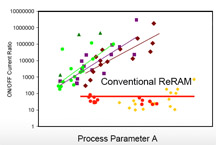Friday, January 16th, 2009
At SEMI’s SMC yesterday, Sung Wook Park, executive vice president and general manager of Hynix Semiconductor, provided a keynote address on the materials needs for mainstream memory chips over the next decade. DRAMs will likely turn into STTRAMs, and NAND Flash will probably be replaced by ReRAM (Ref: Ed’s Threads 080505). Combinatorial materials R&D company Intermolecular claimed to have leaped over the rest of the world in finding an ideal materials set for ReRAM.
Using a three-stage screening process, Intermolecular tested over 75k conditions over a 20 month period to discover and optimize ReRAM; >4k different cells were tested which generated a lot of IP. Flash specs are 10k cycles, while most ReRAM tested so far reaches only ~1k cycles. “Moved to an entirely new materials set, and the result of that was a behavior that is fundamentally different,” explained CEO David Lazovsky. The new materials reportedly meet ION/IOFF>100 (see Figure) and endurance >10k cycles.
When will this new materials set be needed in production? Technology node progression for memory will soon slow down. DRAM scales to ~32nm, and then a completely new technology such as spin-transfer torque (STT, a.k.a. tunneling magneto-resistance, or magnetic tunnel junction) RAM would be needed by 2012. NAND should scale to ~22nm using floating traps, then cross-point ReRAM should work. Phase-change memory (PCM) may also work soon. “The PC RAM has a slight lead, but the ReRAM is gaining a lot of interest,” declared Park.
Tradeoffs are inherent in our era. 8F2 DRAM cells had been the standard, but most companies have already moved to 6F2 cells (based on a “twist” structure). Scaling in DRAM has already led to extreme aspect-ratios (AR) for storage capacitors; >45 for 4xnm node technology, so a tradeoff has been the need to physically link them for mechanical stability. Single-wafer and dry cleaning technologies help in the processing of such extreme structures. Innovation is needed now more than ever before. –E.K.
Tags: DRAM, Flash, materials, memory, MTJ, NAND, PCM, R&D, RAM, ReRAM, SMC, STT, TMR

